
- Majors & Careers
- Online Grad School
- Preparing For Grad School
- Student Life

How to Write a Standout Letter Of Intent For Graduate School

While not all graduate programs ask for a statement of intent, this is a requirement for many grad school applications. A letter of intent for graduate school sets the tone for your application: it introduces you as a person to the selection committee, and provides context to your academic record, qualifications, and professional experience.
Therefore, it’s essential to make your letter of intent as compelling as possible to give you the best chance of admission, especially if you’re trying to get into one of the Ivy Leagues .
Table of Contents
How to Write a Letter of Intent for Grad School
What is a letter of intent for graduate school admission.
A letter of intent is a brief statement which explains your educational background, experiences and motivations for applying to grad school. Some, though not all, graduate programs require you to submit a letter of intent as part of the application process.
A letter of intent is different from a personal statement. While a personal statement deals more with your personal background and passions, a letter of intent focuses more on academic history and professional goals.
The format and content of a letter of intent can vary widely, depending on the graduate school’s preferences. Note that the same is true for both in-person and online Masters programs .
What to Know Before You Start
Before writing a letter of intent for grad school, there are a few key things to keep in mind.
First, each grad school has their own preferences or requirements for letters of intent. Therefore, it’s critical to check the guidelines with the admissions committee before you start preparing your application. Be sure to ask them about the required format, as well as what information you should include.
It’s also important to conduct your own research into the program to determine the kind of things the selection committee will be looking for. This could include factors such as a particular faculty member, the curriculum structure, or learning content.
There’s another important consideration. That’s your academic and professional goals.
- Why are you interested in this particular program?
- What do you want to get out of it?
- How does it fit into your broader career goals?
Answer these questions to help you decide what to include in your letter of intent. This ensures authenticity in your submission. It also sets you apart from anyone else. Your specific desires are your own. They won’t mirror thousands of other applicants.
When you’re ready, daft an outline of the letter. This should cover the main points above. This is an important step to make sure your letter of intent is concise, informative, yet covers all the essential information the admission committee is looking to see.
Once you’ve done all this, you’re ready to start writing your letter of intent.
Read on to learn more about the sections to include, top tips, and letter of intent grad school samples!
Why is a letter of intent important?
If required, your letter of intent plays a vital role in your grad school application that could make the difference between rejection and moving on to the next stage. It provides context to your academic resume, transcripts, and other documentation that gives the reader an idea of who you are as a person.
This can be very compelling to the selection committee, if your letter of intent is strong enough.
It also gives you the opportunity to detail your research interests. This is very valuable if the program has a research component, as you can use your letter of intent to explain your skills and passions in this area.
Through your letter of intent, you can also tell the selection committee about your academic and career goals, helping to convince them that you’re a good fit for the program. Finally, it allows you to showcase your written communication skills, which is a vital skill set for any grad student.
Related: How to Get into Harvard
The Key Parts of a Graduate Letter of Intent
Although the exact format may differ depending on the program’s requirements, there are certain key sections that a letter of intent should typically include.
A letter of intent should generally be structured in the same way as a formal business letter. As such, it should have a header with the name and address of the recipient, usually the admissions counselor or director for the program you’re applying to.
Below this and on a separate line you should put the date that you’re printing the letter.
Directly below the header, be sure to include a formal salutation, typically “Dear…” followed by the recipient’s name. If you don’t know the name of the admissions counselor or graduate program director – find out.
This should be the person in charge of selecting candidates for that particular program. Check the program’s website, and if you can’t find the info that way, send the admissions office an email to ask!
Opening Paragraph
The opening paragraph is one of the most important parts of a letter of intent graduate school. This is your chance to capture the attention of the selection committee and encourage them to keep reading.
In the introduction, you should briefly explain why you want to apply for the program and summarize your academic experience. You can also introduce the key points that you’ll elaborate on later in the letter.
Qualifications and Educational Background
Following your introductory paragraph, you can launch straight into talking about your qualifications and background. This is the time to flesh out the information in your academic resume. You can mention important awards, and impressive academic results.
Along with your academic history, you can also describe relevant professional experience.
Although a letter of intent is mostly focused on the academic sphere, professional experience is worth mentioning if it directly relates to the field you want to study, or if you’ve been working for some years since completing your undergraduate degree.
Research or Study Projects
The next section of the letter should detail your key academic accomplishments, such as major research and study projects. You could also include your professional achievements, if you’re an experienced professional rather than a recent graduate.
You can also mention relevant prizes and awards you’ve received, either in the academic or professional sphere. Be sure to include anything that demonstrates your ability to complete the work required of graduate students.
Goals and Motivations
The previous paragraphs are designed to convince the selection committee that you’re a great fit for their program. This final section is geared towards explaining why the program is a great fit for you.
This is crucial, because admissions counselors look for candidates who are motivated and passionate about the program, rather than those who may drop out due to lack of interest.
Here, you should talk about what draws you to this grad program specifically, whether it is the unique curriculum, a renowned faculty member, flexible program structure, excellent opportunities for internships, or something else.
This is also a great time to describe your future goals, and how the program will help you to work towards them. A strong statement of intent for grad school will cover both educational goals and career goals. You could also mention personal reasons and motivations, such as a desire to increase your knowledge in a certain area, or a particular passion for the field.
Closing Paragraph
End your letter of intent with a short paragraph of around two sentences, summarizing your key points. You may also want to thank the reader for their time or note that you’re looking forward to hearing from them regarding your application.
Don’t skip over or rush your closing statement. Though brief, this is a vital part of your letter of intent: it should bring everything together and leave a strong impression that convinces the selection committee to move your application on to the next stage.
As you are following a business letter format, be sure to include a formal sign off (such as “Sincerely” or “Kind regards”) followed by your full name.
Graduate School Letter of Intent Template and Example
Grad school letter of intent template.
Fill in this template to create your own masters program letter of intent, or adapt it to create a letter to accompany your application for a doctorate or professional program:
[Name and Address of Admissions Counselor]
Dear [Name of Admissions Counselor]
Opening paragraph:
- Introduce yourself and explain why you want to apply in one sentence
- Briefly summarize your qualifications, education history, key motivations, and what you will discuss in the rest of the letter
Paragraph 1: Qualifications and Educational Background
- Detail your undergraduate studies and qualifications
- Describe your major academic accomplishments
Paragraph 2: Major Projects
- Explain your major research and/or study projects
- Cover your professional journey and describe experience relevant to the program
Paragraph 3: Goals and Motivations
- Talk about why you’re interested the program
- Mention your professional and academic goals
[Your signature]
Letter of Intent Example Grad School
Here’s a sample letter of intention for graduate school based on fictional details to show the key sections, formatting, tone, and type of content you should look to include.
Dr. Rosario Ortega Northwestern University School of Professional Studies 339 East Chicago Avenue Chicago, Illinois 60611
September 12, 2023
Dear Dr. Ortega
[Opening paragraph]
Through my undergraduate studies at Brown and internship at the New York Public Library, I’ve developed a strong passion for North American literature. I’m therefore writing to apply for the Master of Arts in Literature at Northwestern University.
[Qualifications and Educational Background]
I completed my Bachelor of Arts at Brown University in 2023, with a concentration in Literary Arts, with an overall GPA of 6.0. Following graduation, I completed a three-month internship at the New York Public Library, where I worked with the archives department, assisting with a range of archiving tasks as well as completing a major project.
[Major Projects]
During my undergraduate studies, I completed a major research project into leading female African American writers of the 20th century. I received the Harriet Tillman Award in recognition for the high standard of work of my project.
As part of my internship with the New York Public Library, I was responsible for a project to provide access to African American history through the holdings of the library’s collection. Working under the guidance of one of the library’s archive specialists, I applied archival standards to process materials and make them available to researchers and the general public.
[Goals and Motivations]
I’m interested in earning my master’s degree from the School of Professional Studies because of the program’s strong faculty and emphasis on diversity. I am particularly excited to work with Dr. Margaret Hedelman, whose pioneering work on the underrepresentation of African American poets is truly inspiring. I believe that literature is a vital part of North American culture and a reflection on society and, as such, it is essential that we acknowledge authors from all communities, and promote underrepresented voices.
[Closing Paragraph]
I believe that the Master’s of Arts in Literature will best allow me to achieve my goal of becoming an archivist and educator in order to share knowledge of diverse authors and poets with the broader community. Thank you for your consideration.
Robert Garman
Related: Does GPA Matter for Grad School ?
Tips for Writing the Best Letter of Intent for University
Your statement of intent can be a crucial part of your grad school application, so it’s important to make it as strong as possible in order to stand out from the other candidates. Here are some important things to keep in mind to help you put your best foot forward.
Remember the Key Purposes of the Letter
As you write your letter of intent, it’s essential to keep in mind why you’re writing it. This will help you to stay on track and optimize your letter to make it as effective and compelling as possible.
A letter of intent has two primary purposes:
- Highlighting the most important information in your application: your key qualifications, experience, and achievements.
- Showing the selection committee who you are as a person, including your own interests and goals.
Your letter of intent should be concise and closely focused on achieving these two goals. This means that everything you share should contribute to these aims. If you find yourself writing something that doesn’t support one of these two goals, delete it! This is merely unnecessary fluff that detracts from your core message.
Related: Looking for extra flexibility with your finances? Consider this year’s best student credit cards .
Leverage Your Strengths
Though a statement of intent should generally focus on academic history and broadly follow a set format, you can play with standard templates in order to make your letter as compelling as possible.
You may have an impressive level of professional experience that demonstrates your ability to excel at grad school, but your academic history is lackluster or outdated. In this case, it would be better to focus on your professional experience and achievements and only briefly mention your academic history.
On the other hand, if you’ve recently completed your undergraduate degree, you could focus entirely on your academic qualifications, projects, and awards.
If you feel like both your academic and professional history is lacking, talk about your personal story and why you have a passion for the subject matter.
It’s all about leveraging your strengths to present the most compelling case for why the admissions committee should accept you into their program.
Take the Opportunity to Showcase your Writing Skills
Though primarily designed to explain your abilities, experience, and interests, one of the secondary purposes of a letter of intent is to showcase your written communication skills. Written communication is a big part of any graduate program, especially programs with a thesis or dissertation component. This is your chance to show that you can write well.
Therefore, it’s important to ensure that your letter is well-written in a professional style, using proper formatting, grammar, and spelling. If writing is not your strong suit, or if you’re not accustomed to preparing format business letters, take your time to do some prep work.
Read up on the required formatting, style and flow for these kinds of letters. You may even want to practice your formal writing skills through writing exercises.
Carefully Edit your Letter of Intent
As with all aspects of your graduate school application, it’s important to carefully proofread and edit your letter of intent. Graduate programs can receive hundreds, if not thousands, of applications, and they may quickly cull applications based on a range of factors, including poor editing.
Even small errors could result in your application landing on the “discard” pile instead of moving on to the next stage.
Good editing goes much further than checking your letter for stray commas and spelling mistakes. First of all, you want to carefully review the content of the letter to make sure it is compelling, informative, and includes all key information. Then, take another pass to check for grammar, spelling, and punctuation, as well as ensuring that the writing flows well and sounds professional.
Impress with a Winning Letter of Intent
The best graduate programs are highly competitive, so it’s essential to make your application as strong as possible in order to stand out from potentially hundreds, if not thousands of applicants.
This is particularly true for your letter of intent which, if required, sets the tone for your application and can help convince the admissions committee to move you forward to the next stage.
Craft a compelling letter of intent for graduate school by keeping it concise and well-written, and focused on explaining why you’re a great fit for the program, and it’s a perfect fit for you.
While you’re preparing your winning grad school application, take a look at our guide to how to ask a professional for a letter of recommendation .
Do All Schools Require a Letter of Intent?
No – not all schools require a letter of intent. While some graduate programs ask for a letter of intent as part of the application process, others demand a personal statement instead. Always check the application requirements well in advance of the deadline, so you’ll have plenty of time to put together a strong application.
How Long Should a Letter of Intent Be?
A letter of intent for a masters program or other graduate program should be around 3-4 paragraphs long, as well as short opening and closing paragraphs, header, and sign off. Generally speaking, an ideal letter of intent is between 300 and 450 words, and no more than one page. However, each program may have its own requirements, so be sure to check with the admissions office before preparing your letter.
How Should You Format a Letter of Intent?
Some programs require specific formatting, so be sure to ask the admissions office if they have any specific requirements for the letter of intent. If they don’t, you should standard formatting for a business letter: a header with the recipient’s name and address, the date, formal greeting, opening paragraph, body with 3-4 paragraphs describing your history, achievements, and interest in the program, a short closing paragraph, and a formal sign off. Be sure to use a professional font, size, spacing, and margins, in line with a business letter.

Lisa Marlin
Lisa is a full-time writer specializing in career advice, further education, and personal development. She works from all over the world, and when not writing you'll find her hiking, practicing yoga, or enjoying a glass of Malbec.
- Lisa Marlin https://blog.thegradcafe.com/author/lisa-marlin/ 12 Best Laptops for Computer Science Students
- Lisa Marlin https://blog.thegradcafe.com/author/lisa-marlin/ ACBSP Vs AACSB: Which Business Program Accreditations is Better?
- Lisa Marlin https://blog.thegradcafe.com/author/lisa-marlin/ BA vs BS: What You Need to Know [2024 Guide]
- Lisa Marlin https://blog.thegradcafe.com/author/lisa-marlin/ The 19 Best MBA Scholarships to Apply for [2024-2025]
As a Class of 2024 Graduate, You’re Part Of The Job-Hopping Generation
How to apply to grad school: ultimate 2024 guide, related posts.
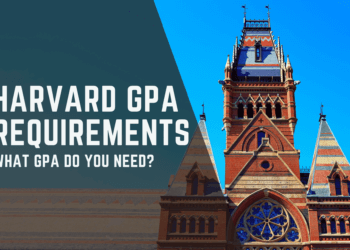
Harvard GPA Requirements: What GPA Do You Need to Get In?

Grad School Resume 2024: Tips, FAQs, and Templates

How to Write the Best Personal Statement for Graduate School

How to Get a Master’s Without a Bachelor’s: The Complete Guide

Top 20 Best PhD Programs in California [Online and On-Campus] 2024

Leave a Reply Cancel reply
Your email address will not be published. Required fields are marked *
Save my name, email, and website in this browser for the next time I comment.
Recent Posts
- Applying to Big Tech This Year? Here’s How to Ace It.
- 12 Best Laptops for Computer Science Students
- Is a Master’s Degree Worth It? [2024 Guide]
- 73% of job seekers believe a degree is needed for a well-paying role–but is it?
- Graduate Certificate vs Degree: What’s the Difference? [2024 Guide]

© 2024 TheGradCafe.com All rights reserved
- Partner With Us
- Results Search
- Submit Your Results
- Write For Us
- Online Degree Explore Bachelor’s & Master’s degrees
- MasterTrack™ Earn credit towards a Master’s degree
- University Certificates Advance your career with graduate-level learning
- Top Courses
- Join for Free
How to Write a Standout Letter of Intent for Graduate School
A letter of intent—sometimes called a statement of purpose—is a way to introduce yourself to a graduate admissions committee. Learn what to include as you get ready to apply to grad school.
![application letter for graduate degree [Featured image] A young Black woman smiles off into the distance while sitting in front of her laptop.](https://d3njjcbhbojbot.cloudfront.net/api/utilities/v1/imageproxy/https://images.ctfassets.net/wp1lcwdav1p1/7jEff0zwTrffxQJpkfewta/d373cab82256ab13449e989536191e30/iStock-878841254.jpg?w=1500&h=680&q=60&fit=fill&f=faces&fm=jpg&fl=progressive&auto=format%2Ccompress&dpr=1&w=1000)
When you apply to graduate school, you’ll need to pull together a variety of materials for the admissions committee to review, including your CV , undergraduate transcripts, letters of recommendation , and in some cases GRE or GMAT scores (if your school uses a standardized graduate admissions test). Part of your application will also include a letter of intent —sometimes called a statement of purpose—which is typically a one-page letter stating your goals in pursuing graduate school.
A letter of intent is an opportunity for a committee to hear directly from you and learn more about your interest in their program. It’s also a chance for them to get a sense of your voice, research interests, and ability to communicate. In this article, we’ll go over what you’ll need to include when writing a letter of intent and tips for crafting a strong one.
Important steps before writing your letter
A letter of intent and a cover letter for a job have a lot in common, so if you’ve written the latter, it may help you craft the former. Both documents tend to require research and more detail about your strengths and goals.
It’s recommended that you apply to between four and six graduate schools , selecting the departments or programs that most closely align with your goals and needs. In that case, before you begin drafting your letter, it’s worthwhile to take some time and:
Reflect on your goals: Before you apply to specific programs, take some time to reflect on why you’re interested in attending graduate school. In other words, what are your goals? These can be academic goals, such as learning more about a subject or moving into an area unrelated to your bachelor’s degree . Or your goals can be motivated by your career aspirations.
Conduct research: Each program you apply to will want to know why you’re interested in attending them specifically. Is it because of a particular faculty member? Are the research opportunities desirable? Or does the curriculum structure meet your learning goals? You don’t need to include just one reason, but it’s helpful to know enough about each program so that you can discuss how it fits your larger goals.
Take notes about the programs you’re most interested in attending and why. Think about how these reasons line up with your goals—and even your needs. If you need to keep working part-time or full-time, perhaps a program’s flexibility will be worth mentioning. Or if relocating to a school isn’t an option for you, then finding online programs and calling out the benefit of studying remotely is worth mentioning.
Letter of intent sections
Once you’ve taken the foundational steps noted above, it’s time to start drafting your letter of intent. These documents tend to follow a straightforward format that includes a header, introduction, explanation of your research interests, what you’ve accomplished so far (either academically, professionally, or personally), your goals in attending grad school, and a conclusion. You can adjust the main sections—interests, goals, and accomplishments—to best suit the order of your overall narrative. Let’s review each one before turning to a full example.
Your letter of intent should follow the format of a formal business letter, which includes the name and address of the person you’re addressing, the date, and a formal salutation. Typically, you’ll want to find each program’s graduate director and address your letter to them, using the program’s or department’s mailing address (usually found at the bottom of their webpage).
Introduction
Use the first line or two of your letter to officially introduce yourself. You can state your name or take the opportunity to flag what you’re currently doing—or what you’ve previously done—as a way to explain your interest in graduate school.
Explain what you’d like to study and your reasons for doing so at each program. This can be a great time to specify what unique factor attracts you to a program or department, such as a stellar faculty member, unique coursework electives, or job placement support.
Go into detail about what you hope to get out of the program. It may help to think about goals in light of: educational goals and career goals .
Educational goals: These pertain to what you want to learn and why.
Career goals: These pertain to what you hope to do in your career and how your education will help you achieve that.
Your goals don’t need to be limited to education and work. There are other reasons for attending graduate school, such as personal development or an interest in the subject matter. But whatever your ambitions for undertaking an advanced education, it’s good to clarify those intentions in your letter.
Accomplishments
Discuss what makes you stand out as a potential candidate. Many grad school applicants come straight from their undergraduate program, while others might have worked before returning to school. No matter what category applies to you, it’s worth highlighting what you’ve accomplished that showcases your ability to pursue graduate-level work.
Conclusion
Lastly, wrap up your letter with a one- or two-sentence conclusion that briefly restates the points above and thanks the addressee for their time.
Learn more: How to Get a Master’s Degree?
After you develop a rough draft of your letter of intent, it’s a good idea to carve out time to revise and polish it. You may seek feedback from a trusted peer, colleague, family member, or friend, who can give you helpful notes to strengthen your document.
Letter of intent example
Below, we’ve applied the sections we discussed earlier into a complete example. You can reorder the sections about your interests, goals, and accomplishments to align with the overall narrative you’re seeking to create. In other words, there may be times when it’s best to lead with your goals before discussing the other sections, or to open with your interests before moving into your accomplishments and goals.
There’s some flexibility when organizing a letter of intent; you can use that flexibility to reflect your unique story.
Dr. Marcus Williams
X University
Department of Public Health
123 College St.
City, State
December 15, 2022
Dear Dr. Williams:
[Introduction]
After spending the first three years of my career working with data for a notable educational start-up, I’ve grown markedly more interested in how to use that data to benefit public health measures as a biostatistician . I’m therefore writing to apply for the Master of Public Health program at X University.
[Interests]
I’m interested in earning my master’s degree from the Department of Public Health because of the interdisciplinary nature of the program. I believe that taking core courses in a range of interrelated public health subjects, especially epidemiology and environmental health, will provide me with the foundation I need as I pursue a career as a biostatistician after graduation. I’m particularly excited to work with Dr. Harriet Bedelman, whose research on technology’s effect on community health measures has informed my interest in the field.
[Accomplishments]
I’m eager to explore the intersections between public health and data and believe a graduate education is the best way forward. After earning my bachelor’s degree in computer science, with an emphasis on data analysis, I began working as part of the data team at an educational K-12 start-up. I learned a lot about how to design algorithms to work with data, parsing a vast amount of information to provide actionable insights. It's an experience that I believe will set me apart from my peers and allow me to develop interdisciplinary research at X University.
I believe data has the power to inform and improve public health outcomes, especially in light of global health events like the COVID-19 pandemic, and I’m keen to unite my background in data science with my future in public health. In fact, I believe my aptitude for statistics will serve me well in the program.
[Conclusion]
I believe that the Department of Health is the program to best help me achieve my goal of becoming a biostatistician and that I stand to contribute a good deal to my cohort. Thank you for your consideration.
Alexandra James
Why is a letter of intent important?
Letters of intent—or statements of purpose—are important for several reasons:
It gives the admissions committee an idea about who you are.
It frames the application to follow, personalizing some of the other data-driven documents.
It shows why you’re interested in that particular school.
It outlines your research interests and goals in attending graduate school.
Letters of intent also showcase your communication and writing skills , which are both valuable skills that most graduate programs—no matter what you study—expect students to have and continue developing.
Learn more: Is a Master’s Degree Worth It?
Explore further
You’ll find a range of flexible master’s degrees from leading universities on Coursera. Explore degrees in computer science, data, business, and more. Many programs offer a quick response time to applications, such as Arizona State University’s Master of Computer Science , which will get a decision back to you in two to four weeks.
You can get a head start in other programs, like the University of Pennsylvania’s Master of Computer and Information Technology , by completing the school’s Introduction to Programming with Python and Java specialization.
Keep reading
Coursera is the global online learning platform that offers anyone, anywhere access to online course...
This content has been made available for informational purposes only. Learners are advised to conduct additional research to ensure that courses and other credentials pursued meet their personal, professional, and financial goals.
- Graduate School
Graduate School Cover Letter Examples
With writing tips and a step-by-step guide.

Looking at graduate school cover letter examples is a good idea if you plan on applying to a graduate school program, as you may be required to include a cover letter with your CV for graduate school and other application components. Even though it is not a required document for all grad school programs, a well-written graduate school cover letter can help you stand out to the admissions committee and improve your chances of being accepted into your chosen program. This is especially true if you are applying to a highly selective institution or trying to get into graduate school with a low GPA.
This blog will discuss everything you need to know about writing a cover letter for graduate school. You will learn why cover letters are important, learn tips to make your graduate school cover letter stand out, and you will get to review cover letter samples that will inspire you to write your own.
>> Want us to help you get accepted? Schedule a free strategy call here . <<
Article Contents 10 min read
What is a graduate school cover letter.
A graduate school cover letter is a brief letter that applicants attach to their graduate school application. Much like a work cover letter, such as a research assistant cover letter , for example, graduate school cover letters are meant to introduce you and your application to the reader. They give you an opportunity to make an excellent first impression, tell the admission committee that you are interested in their graduate school program and why you believe it is a good fit for you.
Graduate school cover letters have become less popular as graduate schools typically ask students to fill out their personal information and submit materials online. If you are sending specific application materials or your entire application by mail, then you will need to include a graduate school cover letter. Additionally, a few institutions, like the University of Illinois graduate college, for example, require students to submit a graduate school cover letter with their application, even when it is online.
Furthermore, even when a graduate program does not explicitly ask for a cover letter, including a well-written and informative letter can help differentiate you from the other students by leaving a lasting impression on the admission committee, thus increasing your chances of admission. That said, before you start writing a cover letter for such a program, you should verify the school's admissions website to ensure that the school accepts additional documents.
It should also be noted that many graduate students look for work and research opportunities at the school that they will be attending. If that is the case for you, then you will need a graduate school cover letter with your application for that school-related internship, job, or research opportunity. For example, if you’re interested in conducting research with a specific professor while you complete your master’s, then it would be a good idea to send them your application with a cover letter attached so that you can communicate your suitability for their research project.
Graduate school cover letters are academic letters, meaning that they need to be formatted in a way that is professional, clear, and concise. Your graduate school cover letter should be no longer than a page, written in a classic font that is easy to read, such as Times New Roman or Calibri, sized 11 or 12.
The text of your letter should be organized and separated into paragraphs. Keep in mind that your letter may go through several readers, and not all of them may be experts in the field you intend to study, so do not use overly technical language or industry-specific jargon. Keep your language succinct, clear, and consistent throughout the letter.
Lastly, your letter needs to provide a quick introduction to you as a candidate and pique the reader's interest so that they want to read the rest of your application. This means that you should not use your cover letter to list all of the experiences and skills that make you perfect for this graduate program. Simply express your interest in the program, select one or two experiences, skills, or values to focus on, and relate those to your suitability for the program you're applying for.
Wondering how to get into grad school with a lower GPA?
Step 1: Brainstorm & plan
The first thing you want to do before you start working on your cover letter, or any graduate school admission essay, is make a plan. Think about what you want to say in your cover letter and write it down. Remember that you only have a few paragraphs to work with, and you do not want to repeat information from your personal statement or other application components.
Once you know what you want your cover letter to say, organize it so that it flows nicely, and it is easy to follow. Your graduate school cover letter should follow the structure of a typical letter. It should have an introductory paragraph, the main body, and a closing paragraph.
Step 2: Address your letter
As mentioned earlier, your graduate school cover letter is, in fact, a letter! Therefore, you should begin by addressing it the way you would in a formal letter. Write your full name and mailing address at the very top. We also recommend including your email address and phone number, but this is optional. On the following line, write out the date, and then write the recipient's name (typically, this is the name of the head of the department or just the name of the school you are applying to) and their address. You should verify the school's admissions webpage for this information. If it is unclear and you are unsure whom to address in the letter, contact the school and ask for this information to ensure that your documents get to the right person.
This first section of your letter should follow this template:
1234 Imaginary Lane
NameofCity, TN 34421
December 12, 20XX
Dr. John Smith
Department of Psychology
BeMo Academic University
66 University Circle
NameofCity, TN 34457
Once again, because this is a formal letter, you want to open your letter with the appropriate greeting or a personal salutation. If you have the name of a specific recipient, you can use the most common salutation for graduate school cover letters, which is "Dear [recipient's name]." Do not forget to include the recipient's title if you have it. If you do not have the name of a specific recipient, then you can simply address the letter "To Whom It May Concern".
Step 4: Introduce yourself and express your interest in the graduate program
The reader will already have your name at the top of the page, but your introductory paragraph should tell them why you're writing this graduate school cover letter. You should use it to state your interest in your chosen graduate program and briefly mention your academic background and accomplishments thus far.
Take a look at this example for context:
I am pleased to submit my application for the Master of Applied Psychology program at X university. As a recent psychology graduate of YZ university, this graduate program is the perfect next step toward achieving my goal of becoming a clinical psychologist.
Step 5: Talk about your suitability for this program
This is the main body of your graduate school cover letter. You should try to limit this to one paragraph, but you can use up to two of them if necessary. You should briefly touch on why you chose this particular school and program, what skills you have that have prepared you for this program, and what makes you an ideal applicant.
You can talk about what you intend to do after this degree or specific professors and faculty members you wish to work with. The information you share here will be personal, so there is no golden template. Just ensure that it is written in an organized fashion that is easy to read and understand.
Step 6: Conclude and close your letter
In your last paragraph, make sure you thank the recipient for their time and consideration. You should also encourage them to reach out to you if they need additional information, or if they have any questions. Then finally, You can close your cover letter with a warm, professional closing salutation. "Sincerely" or "Warm Regards" followed by your name are some acceptable closing salutations you can use.
Step 7: List enclosed documents
This section of your graduate school cover letter will look different depending on the school you are applying to, and the application format used. If you are applying by mail, you should list the enclosed documents in the same envelope as your cover letter. If you are applying online or by email, verify that all of the documents listed on your cover letter are attached and ready to send.
This section should be at the very bottom of the page. It should list the documents in a bullet point format, in the order in which they are enclosed. The list should look something like this:
Sincerely,
Jane Doe
- Program application form
- Statement of purpose
- Academic transcripts
Letters of recommendation
Graduate school cover letter examples
Graduate school cover letter example #1.
Candice Williams
1234 Dream St.
Winnipeg, MB R3J 8T6
[email protected]
204-990-887
August 12, 20xx
Dr. Trevor Thorne
Department of English, Theatre, Film & Media
Toronto, ON M4C 2Y9
Dear Dr. Thorne,
I am excited to submit my application for consideration for the English literature master's program at BeMo Academic University. I have spent the past four years learning the basics of literature analysis through my bachelor's degree in the field, and I am eager to take this next step in my educational journey in order to further my training.
My undergraduate studies allowed me to explore and learn about different forms of literature from around the world. Still, I often found myself drawn to the impressive works of Shakespeare, Milton, Bronte, and many other great English writers. I had the opportunity to study in London for a year, where I attended a seminar on the impact of Charlotte Bronte's work on modern feminism led by none other than Prof. Jane Smith. She is one of the many brilliant professors in the English, Theatre, Film & Media department at BeMo that I hope to learn from.
You will find enclosed the required application documents, including my academic CV, which provides more information on the research I have been able to do and publish so far in my short academic career. I am especially interested in the role that authors such as William Shakespeare played in the development of modern English, and I wish to explore that further through research. I feel that the rigorous curriculum this program offers will inform my future writing and research efforts, and allow me to achieve my goals.
Thank you for your time, attention, and consideration. It is truly appreciated. Please do not hesitate to contact me if you require any additional information.
Program application form
Statement of purpose
Graduate CV
Official undergraduate transcripts
Angela Wong
102-9876 Mainland Rd.
New Haven, CT 44567
[email protected]
April 8, 20XX
University of BeMo
175 Academy lane
New York, NY 34567
To whom it may concern,
It is my pleasure to submit my application for the Master's degree in Early Childhood Development in the Psychology department at The University of BeMo. I am currently completing my bachelor's degree in psychology and plan to graduate in the fall. Since my goal is to pursue a career as an educational psychologist, this particular program is the perfect next step toward achieving my goal.
My undergraduate degree includes coursework in childhood psychology, special needs education, school and family crisis intervention, and many other courses that have given me the basics required to keep up with the thorough coursework that awaits me in your rigorous program.
I have also gained valuable knowledge in the field through shadowing and internships in different schools in my community. Observing other child educators at work confirmed that this is the right career path for me, and it motivated me anew to learn how I can best help children develop a love of learning from the early stages of their educational careers. I know that there is only so much I can learn from observing, and the fact that this program provides six months of hands-on training is one of the many reasons why I am hoping to be a student at BeMo next year.
Thank you for your time and consideration. Please do not hesitate to contact me if you require any additional information or documents. I look forward to hearing from you soon.
Research Interest Statement
Cover letters are supposed to be a brief introduction to your application, so unless otherwise specified by the school, they should not be longer than one page. We recommend sticking to three to four paragraphs, as this is long enough to share substantial information without losing your audience. Keep in mind that your reader will also be reviewing your other application components, so you do not need to address everything in this one letter. The information in your other application components, such as your statement of purpose , will complement your cover letter. So, treat your cover letter like a summary of your candidacy; keep it short but impactful.
Have you started working your graduate school CV? Check out this video for tips:

Be genuine & professional
The individual or committee that will review your application will probably be people that help run the program you're applying to. It is, therefore, best that they get a sense of who you genuinely are. Communicate honestly and let your personality shine through. This will help make your cover letter more memorable. That said, keep in mind that this is a professional document and that genuine does not mean informal or unprofessional. Your tone should still be courteous and consistent throughout the letter.
Proofread & edit carefully
We cannot stress how important this is. Remember that your graduate school cover letter will be one of, if not the first, document that the admissions committee will see from your application. You do not want their first impression of you to be negative. Your letter should be easy to read and follow, and it should be error-free.
Take the time to review your letter multiple times and edit for flow, grammar, spelling, punctuation, and typos. Better yet, reach out to a grad school essay tutor for assistance. They can review your cover letter and help you edit it to make sure it is up to par.
Grad school essay tutors can also help you with other tricky written application components, such as grad school career goals statements . So, do not hesitate to contact one if you need grad school application help. ","label":"Bonus tip","title":"Bonus tip"}]" code="tab1" template="BlogArticle">
It is a brief letter that you attach to your graduate school application. This letter should state your interest in the program, and briefly explain why you chose it, as well as why you are a good fit for it.
Many programs do not request graduate school cover letters, but they are more common than most people think. Additionally, several programs accept grad school cover letters even when not required, so you can still submit a cover letter to help your application stand out.
That depends on the program that you are applying to. Some schools may request a cover letter for online applications, and others may not require one, but they allow students to submit them as an optional component.
Graduate school cover letters are not replacements for admission essays like a personal statement or statement of intent . So if your school requires a graduate school cover letter, do not assume that this means you will not have to write any grad school admission essays.
Unless you are given the name of a specific member of the admission committee, you should address your graduate school cover letter to the "Admissions team," "[subject] Head of Department," or "To Whom It May Concern."
You can make your graduate school cover letter stand out by making sure your personality shines through in your writing, telling a short anecdote or interesting fact about you in the body of the letter, and detailing your relevant skills and experience.
Graduate school can be pretty competitive, but the level of competition depends on the specific program you will be applying to. Some programs have acceptance rates as high as 60%, while others admit less than 10% of applicants.
Graduate school advisors are admission experts who help students plan and prepare for graduate school applications.
Want more free tips? Subscribe to our channels for more free and useful content!
Apple Podcasts
Like our blog? Write for us ! >>
Have a question ask our admissions experts below and we'll answer your questions, get started now.
Talk to one of our admissions experts
Our site uses cookies. By using our website, you agree with our cookie policy .
FREE Training Webinar:
How to make your grad school application stand out, (and avoid the top 5 mistakes that get most rejected).
Time Sensitive. Limited Spots Available:
We guarantee you'll get into grad school or you don't pay.
Swipe up to see a great offer!
Testimonials
Free Resources
PrepScholar GRE Prep
Gre prep online guides and tips, do you need a cover letter for graduate school applications.
Applying to graduate school means getting together a lot of materials. Most likely, you’ll need transcripts, letters of recommendation, a CV or resume, and a statement of purpose—but do you also need a cover letter for graduate school?
Read on to learn whether you need to submit a graduate school cover letter and how to make one. We’ll also give you six essential tips for making your cover letter for graduate school shine.
Do You Need a Cover Letter for Graduate School?
Generally, you don’t need to submit a cover letter with your graduate school application. Since most programs require you to input your personal information using an online application system, you usually won’t have to submit a separate cover letter as well.
In fact, your statement of purpose already accomplishes most of what a cover letter does: it introduces who you are as well as your academic interests, accomplishments, and goals. Therefore, you most likely won’t need to write a cover letter for your application.
Rarely, a program may ask you to submit a cover letter with your application (or allow you to submit one, even if it’s not required). If you are applying to graduate school by mail, you may want (or need) to include a cover letter in order to highlight your interest in the program and ensure it reaches the correct department.
However, most programs require you to apply online, so you can’t send in an application by mail unless your program allows it. Aside from these relatively isolated cases, you shouldn’t need to submit a cover letter for graduate school.
That said, if you’re applying for a school-related job or internship, it’s common (and often necessary) to submit a cover letter with your application. For example, if you were a current grad student looking to conduct research under a specific professor, you could submit a cover letter to that professor explaining who you are and why you’re interested in conducting research with him or her.
Quick side note: we've created the world's leading online GRE prep program that adapts to you and your strengths and weaknesses. Not sure what to study? Confused by how to improve your score? We give you minute by minute guide.
You don't NEED a prep program to get a great GRE score. But we believe PrepScholar is the best GRE prep program available right now , especially if you find it hard to organize your study schedule and don't know what to study .
Click here to learn how you can improve your GRE score by 7 points, guaranteed .
Or, let’s say you’re applying for a part-time job or internship at your school. In this case, you’ll most likely need to submit a cover letter to introduce yourself, your skills, and your employment history.
How to Write a Cover Letter for Graduate School: Step by Step
If you plan to submit a graduate school cover letter, it’s important to know what to include on it so that you can make a positive impression on the admission committee (or employer).
In this section, we go over the six essential steps for writing a great cover letter for graduate school. With each step, we give you examples using our original graduate school cover letter sample .
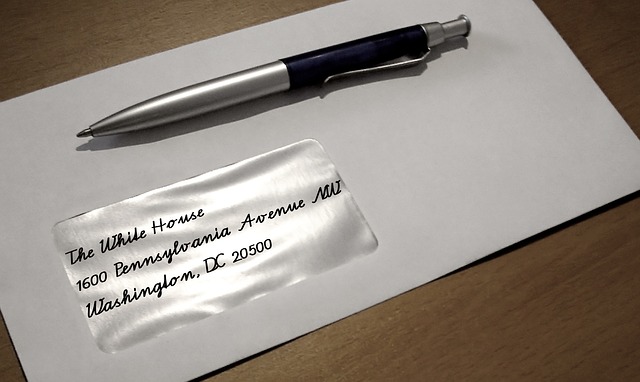
Step 1: Address Your Letter
A clear and organized cover letter is key to making a good impression. Open your letter with your name and contact information followed by your recipient’s name and contact information (as if you were addressing an envelope).
Write your full name first and then use the lines directly beneath it to write your home address. You may also include your phone number and/or email address on a fourth or fifth line after your home address; however, this is optional.
Next, insert a blank space after your contact information and write today’s date. You may use the month-day-year format (e.g., September 4, 2017) or the more formal day-month-year format (e.g., 4 September 2017). Either is fine!
Leave another blank space after the date and write your recipient’s contact information (i.e., to whom you’re sending your cover letter and application).
The name you use here depends on where you’re sending your application. If applying for admission to a graduate program, address your letter to either the head of the department or the head of the admission committee. If you’re not sure whom to address your letter to, contact your program and ask.
Write the name of the recipient with his or her title, if applicable. On the next line, write the name of the department/school for which the recipient works along with the address of the department/school.
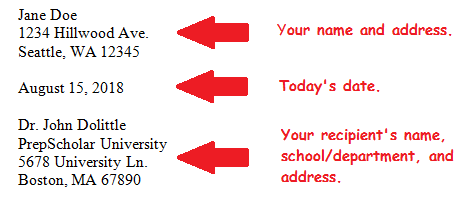
Step 2: Use a Salutation
Like all letters, you should begin your cover letter with a greeting, or salutation, to your recipient.
The most common salutation for cover letters is “Dear [Recipent’s Name]” followed by a comma or a colon. A comma is a little less formal than a colon, but either mark is acceptable.
If you can’t figure out whom to address your cover letter to, write, “Dear Head of Admissions,” “Dear Graduate Coordinator,” or “To Whom It May Concern.” All of these salutations are acceptable, though less personal than a name; thus, it’s best to find a specific person to address your letter to.
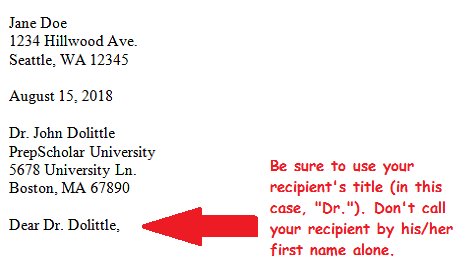
Step 3: Introduce Yourself (Paragraph 1)
Now, we get to the heart of the cover letter. Use this first paragraph to briefly introduce yourself and what program or position you’re applying for. Also, talk a little about what your background in the field is, why you’re interested in this position/program, and how you heard about it.
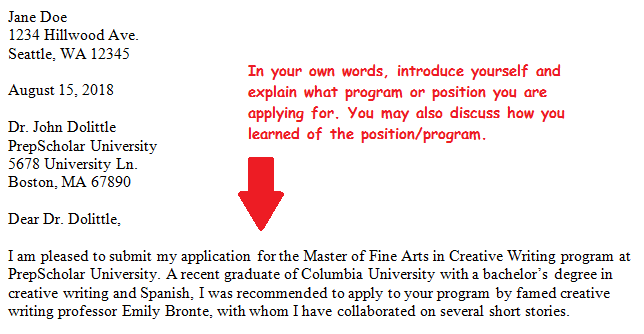
Step 4: Summarize Your Background and Qualifications (Paragraph 2)
For this next paragraph, you’ll give a brief summary of any relevant skills and experiences you have that make you an ideal applicant for this program/position. Be sure to focus on transferrable skills— skills that can be applied across a range of fields and positions.
In addition, think deeply about why you’re drawn to this program/school and what it can do for you. What are your research interests and how will this program help you fulfill them? What do you plan to do after completing the program?
Finally, consider how you’ll fit with the program. Do your interests match what the program offers or specializes in? Are there any specific professors or faculty members you wish to work with?
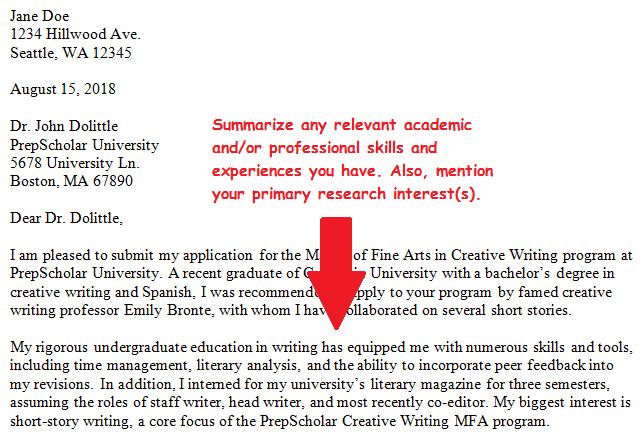
Step 5: Thank Your Reader and List Enclosed Materials (Paragraph 3)
The final paragraph will be a short concluding paragraph in which you thank your reader(s) and give a list of enclosed materials.
When listing what’s enclosed, you may use commas or insert a short bullet list. Normally, you’ll enclose some or all of the following materials:
- Application for the program/position
- Statement of purpose
- Transcripts
- Letters of recommendation
Be sure to list the enclosed materials in the order in which they’re enclosed. Programs may ask you to submit materials in a specific order, so check that you’re following your program’s directions exactly (and aren’t forgetting to include any documents either).
Another option is to include a list of your enclosed materials at the end of your letter instead of in this final paragraph (see step 6 for more information).
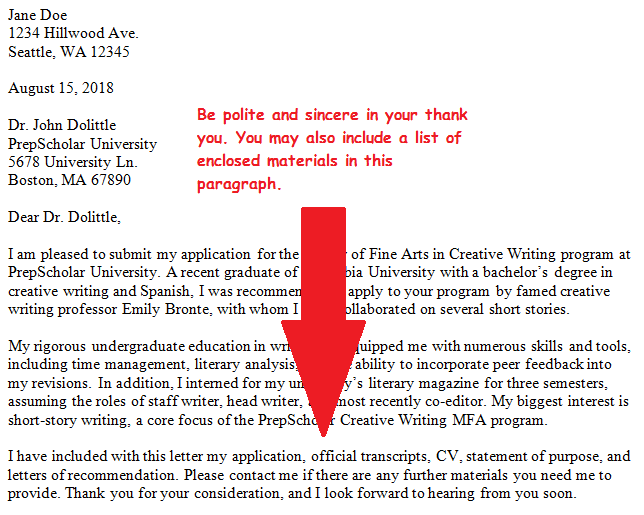
Step 6: Add a Closing Greeting
The last step is to wrap up your letter with a polite closing salutation. There are many greetings you can use to close your letter, such as “Sincerely,” “Yours Truly,” “Warm Regards,” and “Respectfully Yours.”
Want to improve your GRE score by 7 points? We have the industry's leading GRE prep program. Built by world-class instructors with 99th percentile GRE scores , the program learns your strengths and weaknesses through machine learning data science, then customizes your prep program to you so you get the most effective prep possible.
Try our 5-day full access trial for free:
After this greeting, insert a blank line and then type your name. Traditionally, you’d insert three or four blank spaces before typing your name; these spaces would then be used to sign your name in pen. Nowadays it’s OK to skip this step, especially if you’re trying to save space!
Take care to avoid any overly sentimental greetings, such as “Love” or “Forever Yours,” as these are inappropriate for a professional cover letter. Likewise, avoid using the single-word closing “From,” as this can sound a bit rigid and emotionless.
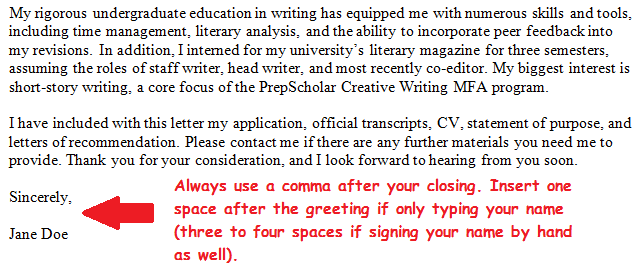
As I mentioned before, you may also insert a list of enclosed materials after your greeting (if you didn’t list them in your concluding paragraph). To do this, insert a space after your typed name and write “Enclosed,” “Enclosure,” or “Enc” followed by a colon. Then, insert a bullet list of the enclosed materials (in the order in which they’re enclosed). Here’s an example:

6 Tips for a Great Graduate School Cover Letter
Your cover letter for graduate school needs to make a great first impression on your program’s admission committee. Here are our top tips for ensuring your cover letter exceeds even your own expectations.
#1: Use a Polite, Professional, and Positive Tone
Because your cover letter is the first document the admission committee will see, be sure to do the following:
- Avoid slang and casual phrases. Nothing says unprofessional like “gotta” and “gonna,” so limit these words to conversations only. Remember, the cover letter is a formal document, much like an essay for school, so it’s better to err on the side of too formal than on the side of too casual.
- Be enthusiastic. Nobody wants to admit an unenthusiastic applicant, so use strong, positive words to convey your pleasure in applying to the program. Stick with upbeat words and phrases such as “happy,” “pleased,” “excited,” “thankful,” “accomplished,” etc.
- Thank your readers. Being polite is all about saying “thank you.” In your letter, thank your readers for their consideration and make it clear that you understand they’re spending a lot of time looking over your application. Don’t thank them over and over, though—this wastes valuable space and ultimately makes you sound desperate!
#2: Be Concise
The cover letter is not the time to delve deep into your personal reasons for pursuing a graduate degree (this is for your statement of purpose!), so be concise without forgoing critical facts about you and why you’re applying.
You’ll typically want to keep your cover letter at a maximum of one page, with no more than two to four paragraphs. Since this letter is short, avoid getting verbose: don’t use tons of flowery language or open with a broad statement. Rather, get straight to the point of who you are, what program you’re applying to, and why you’re a qualified candidate.
If you’re not sure what to include in your letter, read through your resume/CV and statement of purpose to make note of what you’ve already mentioned in those documents. Then, cut down (or remove completely) any similar parts in your cover letter. In short, don’t repeat information you’ve already talked in detail about in other parts of your application.
#3: Use a Neutral Font Face, Size, and Color
Because the cover letter is a professional document, you’ll want to keep its format simple and elegant, as you would a school essay.
Stick with basic “generic” fonts, such as Times New Roman, Arial, Tahoma, and Calibri. Don’t get creative by choosing fonts such as Comic Sans and Chiller—this will make your cover letter look wildly unprofessional and implies you’re not taking the application process seriously.
In terms of size, don’t use a super small or super large font size. You shouldn’t need to squeeze in tons of information on your cover letter, so an 11- or 12-point font should work fine.
Finally, use a regular black font color (on regular white computer paper). Wacky colors, like wacky font faces, will only make you look unprofessional!

#4: Single-Space Text
Unlike school essays, for which you always double-space and indent your paragraphs, the cover letter is single-spaced and uses block paragraphs. This means that instead of pressing the “tab” button to indent each paragraph, you’ll separate each paragraph from the next using a single blank space.
You should also insert a blank line when indicating any sort of transition from one element in your cover letter (e.g., a salutation) to another (e.g., a paragraph). Use our graduate school cover letter sample to better understand how spacing should look.
#5: Align Everything Left
On cover letters, everything needs to be aligned left, from your address and date to your salutations and paragraphs. As I mentioned above, you do not need to indent your paragraphs, so keep these aligned left as well.
There’s no need to justify your paragraphs. In fact, I advise against doing this, as the justification tool on Word often inserts bizarre spacing between words, making paragraphs more difficult to read.
#6: Edit and Proofread
Like every part of your application, take time to edit and proofread your cover letter. Go over the technical and stylistic sides of your writing: make sure your paragraphs flow well together, and check that you haven’t made any glaring grammar, spelling, or formatting mistakes. (For specific tips on formatting, see tips 3-5 above as well as our graduate school cover letter sample .)
I also strongly suggest getting someone else to read your cover letter. A separate pair of eyes will ensure that your letter is as clear and cogent as it can be.
Remember, your cover letter is the first part of your application the admission committee will see, so it must be as close as possible to perfect. Typos and errors will set a negative tone for the rest of your application, even if your other materials are strong. Don’t let the cover letter be your downfall!

Recap: How to Write a Cover Letter for Graduate School
Cover letters for graduate school are generally quite rare. Most programs require you to fill out your personal information and submit materials online, so you won’t usually need to submit a cover letter with your application.
That said, if you are applying for a graduate program by mail, have been asked to submit a cover letter, or are applying for a school-related job or internship, you’ll need to know how to write a cover letter for graduate school.
A graduate school cover letter must include the following elements:
- Your name and address
- Your recipient’s name and address
- A greeting (usually “Dear [Name]”)
- Two to three paragraphs explaining who you are, what you’re applying for, and why you’re a qualified applicant
- A concluding paragraph thanking your recipient for considering you and including a list of any enclosed materials (e.g., a statement of purpose, transcripts, letters of recommendation, etc.)
- A closing greeting with your name (typed, or typed and signed)
Finally, to make a great cover letter for graduate school, be sure to follow these six tips:
Want to improve your GRE score by 7+ points?
Check out our best-in-class online GRE prep program . We guarantee your money back if you don't improve your GRE score by 7 points or more.
PrepScholar GRE is entirely online, and it customizes your prep program to your strengths and weaknesses . We also feature 2,000 practice questions , official practice tests, 150 hours of interactive lessons, and 1-on-1 scoring and feedback on your AWA essays.
Check out our 5-day free trial now:
- Use a polite, professional, and positive tone
- Use a neutral font face, size, and color
- Single-space text
- Align everything left
- Edit and proofread
You should now have no trouble creating a strong cover letter for graduate school!
What’s Next?
You know how to write a graduate school cover letter—but what about a CV? A resume? Check out our guides on how to write a CV and resume to learn what to include, what to leave out, and how to raise your odds of getting accepted to your program. And if you get stuck, use our high-quality resume and CV templates as a guide!
Need to write an essay for graduate school, too? Learn how to write a personal statement and how to write a statement of purpose using our in-depth guides and expert tips. We’ve also got samples of both personal statements (coming soon) and statements of purpose .
Ready to improve your GRE score by 7 points?
Author: Hannah Muniz
Hannah graduated summa cum laude from the University of Southern California with a bachelor’s degree in English and East Asian languages and cultures. After graduation, she taught English in Japan for two years via the JET Program. She is passionate about education, writing, and travel. View all posts by Hannah Muniz


How to Apply for Graduate Admission

Application for admission to the Graduate School is a multi-step process. Each graduate program sets its own application deadline. The application process may take several weeks to complete ; you should apply well in advance of the deadline to ensure adequate time to submit all required items. After you apply, keep up with it all by monitoring MyStatus.
Step 1: Complete the Online Application
Applicants to graduate programs at The University of Texas at Austin should complete the appropriate application for admission. Please note that applications can take up to 72 hours to load to the University of Texas at Austin system after submission of the application form.
Complete a U.S. Graduate Application if you are a:
- U.S. citizen
- Permanent resident
- Former student of UT Austin
Complete an International Graduate Application if you are a:
- Non-U.S. citizen
- Non-permanent resident of the United States
Monitor My Status
MyStatus offers applicants secure, individualized information from initial application submission to the final admission decision and beyond. Use it to track the receipt of submitted application materials, to upload required supporting documents, to confirm that your application file is complete, and to get your decision.
After you submit your online application, you’ll receive an email (within 2-3 days) that will provide you with MyStatus login information.
Use it often—it’s the only way you’ll know if items are missing from your application file.
Program-specific applications
Visit the website for the program you are interested in applying to.
- Texas McCombs MBA
- Masters in Professional Accounting
- Masters in Science - Business Analytics
- Masters in Science - Finance
- Masters in Science - Health Care Transformation
- Masters in Science - Information Technology and Management
- Masters in Science - Marketing
- Masters in Science - Technology Commercialization
Engineering
Executive master in public leadership, social work, school of law, dell medical school, all other programs, apply now at applytexas.
Visit the ApplyTexas website to begin your application if your program is listed below.
- Architecture
- Business (some exceptions)
- Communication
- Geosciences
- Information
- Liberal Arts
- Natural Sciences
- Public Affairs
- Intercollegial Program
Step 2: Pay the Application Fee
Pay your non-refundable application fee by credit card (Visa and MasterCard accepted) when you complete the application.
Application Fees:
- MBA (and dual programs with MBA): $200
- MPA: $125
- U.S. Graduate: $65
- International Graduate: $90
If you decide not to pay the application fee when you submit your application, you may pay it later via the above What I Owe link on UT Direct.
- Visa, MasterCard, Discover, American Express and electronic checks are accepted.
Fee Waivers
If you can’t afford the application fee and are a U.S. citizen or permanent resident applying to pursue your first graduate degree, you may be eligible for a fee waiver (not available for the MBA or MPA programs). Fee waivers are not available for international citizens.
If you intend to seek a waiver, do not pay the application fee when prompted. Instead, submit your application and indicate you will pay later.
Demonstrate your need for an application fee waiver by providing a copy of:
- A fee waiver granted by GRE or GMAT; or
- If you are currently enrolled at an institution, your financial aid awards for the previous two semesters showing the source(s) of your funding; or
- If you are not currently enrolled, your tax returns for the last two years.
Submitting documentation
Wait until you receive the email with a link to your MyStatus page, redact your Social Security number from any documentation you plan to send, then email it to [email protected] .
Make sure you include your UT EID in the email; without this information, your request cannot be processed. Please note that it will take 24 to 48 hours from when you submit the application before you receive the status check email – do not send your request prior to receiving that email.
You will be unable to upload any documents to MyStatus until your fee is waived or paid.
Step 3: Submit Transcripts
After satisfying the application fee, provide an official transcript from every senior college you have attended. Even if courses taken at one institution are recorded on another college's transcript, transcripts must be submitted from the institution at which the courses were taken. Failure to list all colleges on the application and provide those transcripts will be considered an intentional omission and may lead to the cancellation of your application for admission or withdrawal of your offer of admission.
Official transcripts bear the facsimile signature of the registrar and the seal of the issuing institution. Transcripts from U.S. colleges or universities must have been produced within the last calendar year, and should include the award of degree printed on the transcript unless coursework is still in progress. Transcripts written in a language other than English must be accompanied by a translation. We do not accept outside evaluations of foreign transcripts. Each transcript (mark sheet) should contain a complete record of studies at the institution from which it is issued (i.e., the subjects taken and grades [marks] earned in each subject).
Below are acceptable submission methods:
If your college or university uses SPEEDE, you can have your transcript(s) sent electronically. Check with the registrar of your institution to find out if transcripts can be sent via the SPEEDE server, as well as instructions for placing an order.
Institutions who utilize SPEEDE
If your college or university uses Parchment, you can have your transcript(s) sent electronically. Please note that due to the sending institution’s system limitations, we cannot currently accept transcripts through Parchment from University of Kansas, Massachusetts Institute of Technology (MIT), National Louis University, Dartmouth College, Southern Utah University and Northwestern University.
If you obtain a Parchment transcript directly and upload it to your application, please be aware it cannot be used to clear you for registration upon admission. As such, you should have the transcript sent directly to UT Austin.
First, review the guidelines for uploading transcripts, linked below. Then, upload a PDF using the Document Upload System . You can upload an official PDF transcript issued by the institution or a scan of the official paper transcript issued to you by the registrar . Uploads will be considered unofficial if admitted, but can be used to process your application for admission. You should redact your Social Security number from the transcript before you upload, but other alterations are not permitted.
Instructions for Uploading Transcripts
Uploads require verification, a process which can take 2 to 3 business days . You should upload your transcripts well in advance of the deadline to allow adequate time for processing. Failure to do so could result in your application being considered late. Do not upload unofficial transcripts or other documents that do not meet requirements, even as temporary placeholders. Doing so will delay processing of your application and could lead to cancellation for being late.
We cannot accept electronic transcripts sent by registrars or third-party entities in any other format (e.g. by email or by links to secure websites). Please do not mail official transcripts or paper copies of your transcripts before you are offered admission. Sending paper copies of documents will significantly delay the processing of your application.
Some programs may also request that you upload copies of your transcripts when submitting the application form. These are not provided to the Office of Graduate Admissions with your application form and therefore cannot be used to fulfill the MyStatus transcript requirements.
Accounting & Nursing
Those applying to the master's program in professional accounting or nursing must also submit transcripts from junior and/or community colleges.
Ordering Transcripts as a Former UT Student
Applicants who have previously attended the university will be automatically billed $20 for transcripts, payable via the What I Owe link above. Do not order transcripts directly from the university registrar, as doing so will slow processing.
Step 4: Submit Test Scores
Most programs require the GRE or GMAT. Check with your program of application to see which test is required or if a waiver is available.
All portions of the test are to be taken on your designated testing date , otherwise, the score will be considered incomplete and cannot be used as part of your application.
International students applying to UT Austin must submit an official score report demonstrating an adequate knowledge of English. See link below for more information.
Additional information for International Students
Ask the appropriate testing agency to send your official test scores as required by your program of application.
GRE
GMAT
TOEFL
IELTS
The Educational Testing Service institution code for the GRE and TOEFL is 6882. The institutional code for the GMAT is 396-44-45. It is not necessary to use a department code, but if you must select one, choose one that is similar to your proposed major.
To fulfill the requirement with scores from the IELTS, please use the IELTS electronic score delivery service to send your scores to the “University of Texas at Austin” account.
The university generally receives scores four to six weeks after a test is taken if the university is designated as a score recipient at the time of testing.
If you are sending scores from a prior test, the scores must still be reportable and valid at the time you submit your application (within the last five years for the GRE or GMAT and two years for the TOEFL or IELTS).
Step 5: Submit Departmental Requirements
All programs have additional requirements that you must complete before they will consider your application for admission.
Letters of recommendation for almost all programs are submitted electronically. (Computer Science, The Butler School of Music, and most master’s programs in Business use an alternate submission method for letters of recommendation. Check the program’s website for complete information.)
You will be given the opportunity to list the name, position, organization and email address for three recommenders when you complete the application. After you submit your application, emails will be sent to your recommenders directing them to a website where they may upload their letters.
MyStatus offers a self-service feature you can use to resend the request email to your recommenders, if necessary. Use it to supply an alternate email address if your recommender’s spam filter blocks the original request or has removed the link. You can also add a new recommender or revise your right-to-view status from “retained” to “waived.”
If your recommender is unable to submit an electronic letter of recommendation, consult the program to which you are applying for instructions.
Upload Additional Materials
Check the website of the program you are applying to for instructions on submitting additional supporting documents.
Most programs will allow you to upload additional required materials via MyStatus.
Admission for Non-Degree Seeking Students
Not all graduate programs offer the option for students to enroll as a non-degree seeker. Before applying, check with the graduate program of interest to see if they offer the non-degree option. The application process for a non-degree seeker is the same as degree seeking students. Enrollment is limited to one year, and a bachelor’s degree is required. Check with the graduate program to determine if the GRE/GMAT is required, as it may be waived for non-degree seeking applicants. The TOEFL/IELTS is required of all international applicants unless they meet the waiver requirements.
All programs have additional requirements such as letters of recommendation or a statement of purpose that you may need complete before they will consider your application. Check with the program you are applying to for instructions on submitting additional supporting documents. Please note that if the program does not require these documents, they may still be requested by the Graduate School before your application can be considered for admission.
If you later decide to seek a graduate degree, you must apply as a degree-seeking student by the program deadline. A degree-seeking student may petition to have applied to the master’s degree up to six semester hours of credit in graduate-level courses earned while enrolled as a non-degree seeking student.
Graduate School
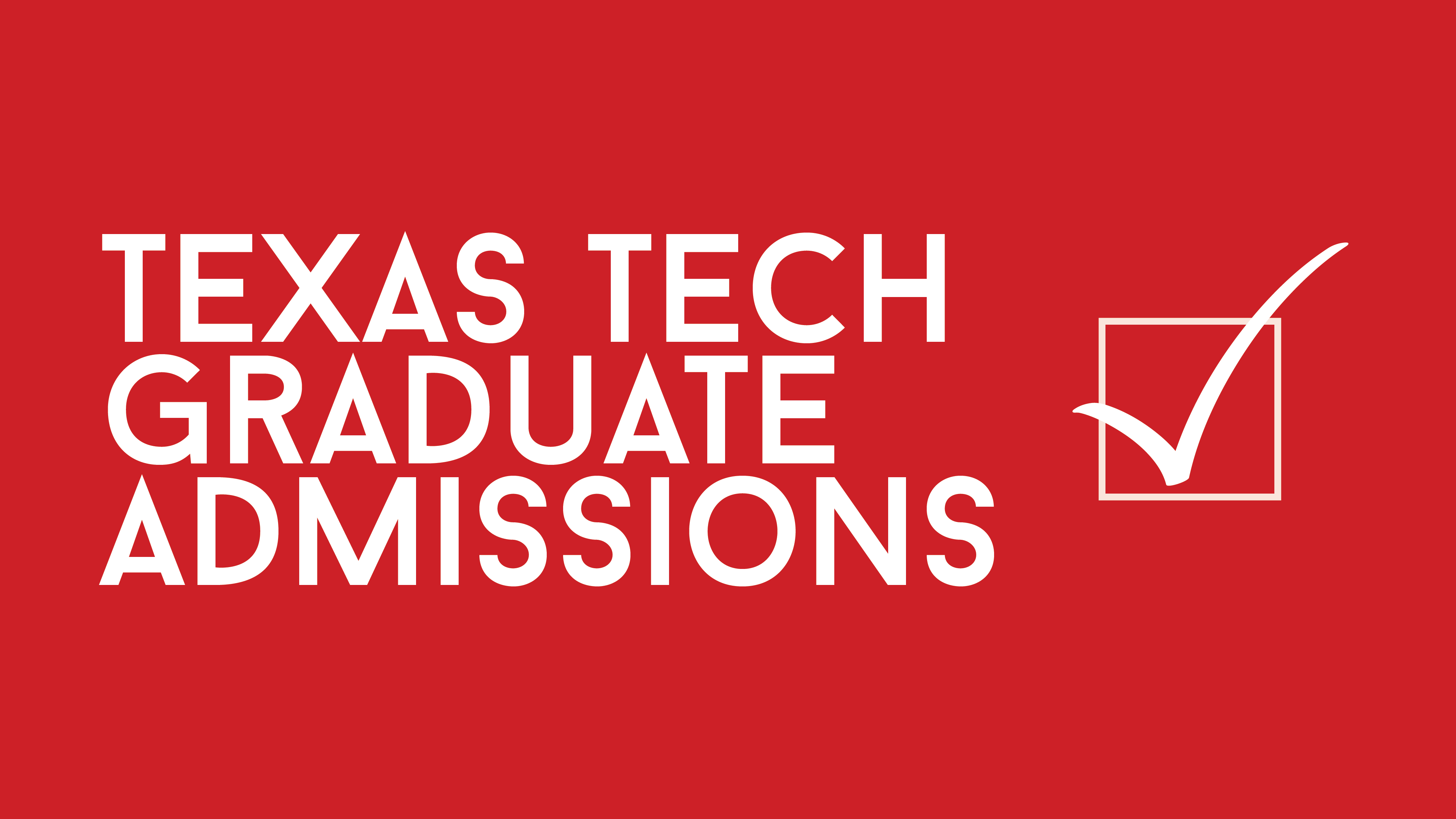
Graduate Admissions
Thank you for your interest in graduate studies at the Texas Tech University. Our online application system is designed to help you easily navigate through the application process and ensure you complete your application in a timely manner.
Before you apply
Before you begin your application to Texas Tech, please make sure to read all the application instructions carefully. You could find these instructions specific to the program you are applying at the time you start your application.
- Deadlines: Since application deadlines vary by program, be sure to confirm your intended program's deadline to ensure that you apply on time.
- Applicants with Foreign Credentials: Please click here to see specific application information before beginning the application.
Ready to Apply
- Unofficial copies of transcripts, and test scores are required for application evaluation purposes. If admitted, you will be required to submit official transcripts, diplomas/degree certificates, and test scores. Please do not send official transcripts until you have received a notice of acceptance from Texas Tech Graduate School.
- Provide Program Materials: In addition to transcripts and test scores, most Texas Tech graduate programs require supplemental materials for admission review. These materials may include (but are not limited to) items such as a statement of purpose, recommendations, writing samples, creative portfolio, etc. Supplemental materials are reviewed by the department only, not the Office of Graduate Admission. Please refer to the homepage of your intended graduate department as well as the instructions on the "Program Materials" quadrant on our online application to verify which supplemental materials are needed. You may also find the required material here.
- While you will be able to add to certain segments on the application (e.g. test scores) post submission, you will not be able to make revisions once the application has been submitted.
- Statement on use of generative AI: As an emerging research institution, Texas Tech University values exploring new technologies such as generative AI tools like ChatGPT. However, we value the applicant's unique voice in their personal statements, writing samples and other application materials. Should you use generative AI, it is important that the use only complements your original ideas and not be used to compose your work entirely. We hold prospective graduate students to the same academic integrity standards as our current students and applicants are expected to abide Texas Tech University's policy on Academic Integrity .
Looking for tuition rates? Click here...
Click Here to Apply!
- U.S domestic applicants
- Master's degree seekers
- Doctoral degree seekers
International
- International applicants
- Like Graduate School on Facebook Like Graduate School on Facebook
- Follow Graduate School on X (twitter) Follow Graduate School on X (twitter)
- Subscribe to Graduate School on YouTube Subscribe to Graduate School on YouTube

IMAGES
VIDEO
COMMENTS
Follow these steps to write a cover letter for graduate school: 1. Begin by addressing your cover letter. The first step to writing any cover letter is addressing it properly. You should begin by writing your full name and address. You may also include your phone number or email address on an additional line, but this is optional.
Here's what you need to include on a cover letter for graduate school: Your name and full mailing address. The date of the cover letter's writing. The name of the professor you're writing to. The department, school, and school's address. A brief introduction paragraph proclaiming your interest.
Key Points. When writing your cover letter for graduate school applications, make sure to: Use the correct formatting: elegant font, margins, spacing, a clear header with all the information. State the graduate program you're applying to, your previous education background, and the reason for you applying.
Example of a letter of intent for graduate school Here's an example of a letter of intent for graduate school: August 21, 2021 Dear Deborah, My name is Anna, and I'm applying for the Masters of Business Administration program at Clearwater University. I took an interest in your university's MBA program because of the interactions I've had with professors in the department during my ...
Consider the following steps when composing your graduate school cover letter. 1. Address the cover letter. Write your full name and mailing address at the top left of the document. Leave a space, then include the date you will send out the letter and accompanying documents. Leave another space and provide a content block for the recipient's ...
A well-organized and deliberate application letter for a fresh graduate lets you highlight the qualities you do have to convince an employer that you're worth a shot. A few writing rules. ... And people with college degrees are much better protected against economic recessions than their degree-less counterparts. This data points to two ...
Examples of cover letters for graduate school Here are some cover letter examples to help you create one for yourself: Example 1 Dear Dr. Adams, It is with excitement that I apply for the English literature program at the University of Missouri. I recently completed my bachelor's in English from William Jewell College and I believe that your program is the perfect next step along the path to ...
A letter of intent for a masters program or other graduate program should be around 3-4 paragraphs long, as well as short opening and closing paragraphs, header, and sign off. Generally speaking, an ideal letter of intent is between 300 and 450 words, and no more than one page.
Header. Your letter of intent should follow the format of a formal business letter, which includes the name and address of the person you're addressing, the date, and a formal salutation. Typically, you'll want to find each program's graduate director and address your letter to them, using the program's or department's mailing address ...
Looking at graduate school cover letter examples is a good idea if you plan on applying to a graduate school program, as you may be required to include a cover letter with your CV for graduate school and other application components. Even though it is not a required document for all grad school programs, a well-written graduate school cover letter can help you stand out to the admissions ...
2518 Lilac Ave. North Charleston, SC, 29405. (803) 847-1043. [email protected]. Dear Ms. Johnston, My name is James Amore, and I'm excited to apply for the position of Junior IT specialist at the French Central Inn, Charleston. I'm a recent graduate (June 2023) in Management Information Systems (MIS) from Charleston Southern ...
Sample Letter of Intent for Graduate School Template. A sample letter of intent template may be helpful to you. A letter of intent does not have to be very long or complicated. Keep it simple and to the point. Include any information the college or university requested in a letter of intent if provided. You may see an example below to use as a ...
Use this Masters cover letter example to finish your application and get hired fast - no frustration, no guesswork. This cover letter example is specifically designed for Masters positions in 2024. Take advantage of our sample sentences + expert guides to download the perfect cover letter in just minutes. 4.4.
An important part of the application process for a Master's degree at an international university is the motivation letter (or cover letter) you are required to write. But how to write the best motivation letter? And why is it so important, anyway? A well-written letter can be a decisive factor in ensuring you a place in your desired Master's programme. It is probably the most personalized ...
2. Create a good recent grad cover letter header. Create a cover letter heading with your name and contact information identical to the one on your resume. Include your basic contact details: phone number, email address, and LinkedIn profile. Your home address is optional, put it there only if applying for stiff corporate jobs.
A graduate cover letter is a professional document that recent college graduates use when they apply for jobs or graduate degree programs. A graduate cover letter acts as an extension of an individual's resume and includes details about college activities and previous professional experiences.
However, most programs require you to apply online, so you can't send in an application by mail unless your program allows it. Aside from these relatively isolated cases, you shouldn't need to submit a cover letter for graduate school. That said, if you're applying for a school-related job or internship, it's common (and often necessary ...
Most master's degree programs, including MS programs through Stanford, require three letters of recommendation. However, it's essential to verify the specific guidelines set by your target institution and program. Once you know the number of letters that are required, it's a good strategy to have additional recommenders in mind.
Graduate School Application Cover Letters: Paper applications and supporting material sent via the post to graduate schools require cover letters. Cover letters should be approximately 1-2 paragraphs and contain: 1) What is enclosed in the envelope and why. Do not make the reader guess why you are sending the following materials.
Applicants with a previous graduate or professional degree from a regionally accredited U.S. institution may be exempt from the Graduate Record Exam or Graduate Management Admission Test at the program's discretion. ... or résumé that is uploaded within your graduate application. 7 Submit Letters of Recommendation. If the program of interest ...
A cover letter is a single-page document that showcases your professional skills, achievements, personality, and your suitability for the desired job position. Overall, a cover letter guides recipients to screen through your job application and examine your suitability. As a fresh graduate, you may not have formal experience in the work field.
Step 1: Complete the Online Application. Applicants to graduate programs at The University of Texas at Austin should complete the appropriate application for admission. Please note that applications can take up to 72 hours to load to the University of Texas at Austin system after submission of the application form.
Apply. Follow these steps to apply to a graduate program. After submitting your application, you will receive a confirmation email. You can check your status by returning to your online application. When a decision is available, it will be published to the Status page of your online application, and you will be notified via email.
If admitted, you will be required to submit official transcripts, diplomas/degree certificates, and test scores. Please do not send official transcripts until you have received a notice of acceptance from Texas Tech Graduate School. Provide Program Materials: In addition to transcripts and test scores, most Texas Tech graduate programs require ...